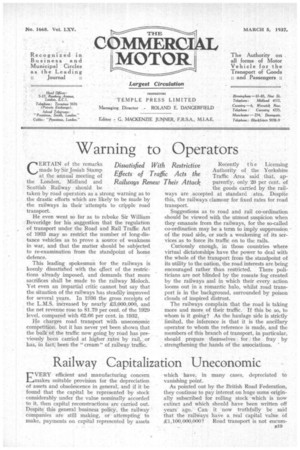Railway Capitalization Uneconomic rVERY efficient and manufacturing concern 4 makes
Page 37

Page 38

If you've noticed an error in this article please click here to report it so we can fix it.
suitable provision for the depreciation of assets and obsolescence in general, and if it be found that the capital be represented by stock considerably under the value nominally accorded to it, then capital reconstructions are carried out. Despite this general business policy, the railway companies are still making, or attempting to make, payments on capital represented by assets which have, in many cases, depreciated to vanishing point.
As pointed out by the British Road Federation, they continue to pay interest on huge sums originally subscribed for rolling stock which is now extinct and which should have been written off years ago. Can it now truthfully be said that the railWays have a real capital value of R1,100,000,000? Road transport is not encum bered with this accretion of 100 years, and it is for this reason, amongst others, that it is able to charge attractive rates which can still be economic.
Pleas as to the hardships inflicted upon railway stockholders are continually being put forward, but this sympathy seems to us to be misplaced. It may have applied to the original holders, but, surely, the majority must have purchased its shares at figures greatly reduced from the original face values, and even comparatively small dividends paid on the latter values should represent a fair return on the actual money invested. If the true value of the railway assets were to be compared with that enormous sum represented by road transport there would not, in our opinion, be an outstanding difference, and there is little or no reason why the interests of the shareholders in our industry should be subjugated to those who own railway stock.
New Thought in Parliament THE 10-minute Bill introduced in Parliament last Tuesday constitutes a most useful contribution to the battle which is being waged by road transport in its fight against excessive control and the continual menace to its interests.
The opportunity was taken to press the need for limitation of objections to haulage-licence applications, with a view to preventing such objections if there be no increase in tonnage and provided that the operator has duly._ carried out his obligations. The suggestion was put forward that all objections should be submitted in writing at least 14 days before the hearing of an application. There is no doubt that the Road Transport Group in Parliament is doing excellent work, is steadily gaining in strength, and is now continually on the look-out for opportunities of presenting the case for the road. Until recently, so far as Parliamentary work was concerned, the railways had it all their own way, but the imperative needs of trade and industry have appealed to the saner and more broadminded elements, and have caused a con version of views amongst many Members, who realize that a railway monopoly would be opposed to the best interests of the nation and must be fought with the utmost vigour.
Possibilities of Rubber Suspension Merit Further Investigation THE high degree of satisfactory service given by the steel laminated springs commonly, used in the suspension systems of commercial vehicles is presumably the reason why So little has been done in the way of trying out new ideas in this field. Whilst rubber has established itself as a practical means for absorbing vibration and shocks, for connecting parts between which a limited relative movement must be permitted, for supporting considerable weight and for withstanding heavy loading, it is still generally used only for purposes which, considered refatively, may be described as minor. For the major purpose of transmitting the weight of the " sprung " portions of a vehicle to the axles, Whilst minimizing the transmission of the movement of the "unsprung" parts to the frame, little use of rubber is made. For engine, gearbox, radiator and other mountings, for propeller-shaft couplings, for shockabsorber connections, and for shackle-pin bushes, rubber is freely used, but, as a substitute for steel springs, it is standardized, we believe, by only one maker. Perhaps the biggest difficulty in designing a rubber-suspension system is that of providing lateral rigidity. With the simple arrangement of an arm and cushion for each wheel there is • nothing positively to check side movements----to replace the wide spring leaf, almost inflexible laterally and anchored at both ends. The addition of a transverse 'radius rod detracts from the simplicity of the layout, as would a diagonal tiepossibly duplicated—running from the hinge point of one arm to the free end of that opposite to it. Weight, cost and opposition to the unorthodox are also impediments. Nevertheless, there seems to be good scope here for Progress in design.




































































































